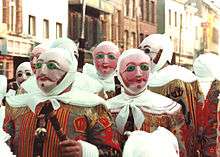Folklore of Belgium
| Part of a series on the |
| Culture of Belgium |
|---|
 |
| History |
| People |
| Languages |
| Cuisine |
| Festivals |
| Religion |
| Art |
| Literature |
|
Music and performing arts |
| Sport |
|
Monuments |
|
Symbols |
|
The Folklore of Belgium is extremely diverse and reflects the rich legacy of cultural and religious influences which have acted on the region throughout its history, even before the establishment of the nation of Belgium in 1830. Much of Belgian folklore is unique to the region in which it is commemorated. Many aspects of folklore are manifested in public processions and parades in Belgian cities; traditions which are kept alive for the amusement of locals and tourists alike.
The term folklore (which is rendered identically in both French and Dutch) is used in Belgium in a much wider sense than in English, chiefly to denote all cultural events open to the public such as traditional festivals and parades. Excluded from folklore are individual (not public) traditions, like the celebration of Easter, food (except if linked to a public cultural event), and events that saw their start only recently, including music festivals such as I Love Techno.
Wallonia
Province of Hainaut

The procession in the town of Binche is one of the best known in Belgium. The Carnival of Binche takes place on Mardi-Gras before Lent. Participants (known as Gilles) wear elaborate costumes in the national colours of Red, Black and Yellow. During the parade, they throw oranges at the crowd.[1] In 2003, it was recognized by UNESCO as one of the Masterpieces of the Oral and Intangible Heritage of Humanity.[1][2]
Each summer, the small town of Ath holds a procession known as the Parade of Giants (or Ducasse). The procession, which traces its origins to the Middle Ages, commemorates the marriage of two giants (Monsieur and Madame Gouyasse or Goliath). A mock ceremony is held in a church, and afterward, the giant fights a shepherd David, in front of the town hall.[1] Onlookers throw coins at the effigies of the giants as they pass for good luck.[1] It is clear that the Christian story of David and Goliath was influential to this festival.
Province of Namur
The town of Andenne holds a festival each year three weeks before Easter known as the "Bear Festival". The story told about the festival is that it commemorates young Charles Martel's defeat of a bear which was terrorizing the region. The bear also features on the town's coat of arms. Sainte-Begge, allegedly related to Martel, is credited with founding the city in 684.[1] 2,000 people participate in the parade, in costume, and 250 Teddy bears are thrown to the public from the town hall.
Province of Liège
The town of Stavelot holds the Blanc Moussis (meaning 'clad in white') festival. Participants wear white sheets and hoods, and masks with pointed noses. The festival recalls the monks of the 15th century who were forbidden from celebrating carnival because of their laziness. Participants wander the streets of the town putting up posters. In the afternoon they shower the crowds with confetti while hitting them with pork bladders.[3]
Province of Luxembourg
The folklore of the Ardennes, in the province of Luxembourg, is particularly rich.
Brussels

The "Ommegang" is one of the most popular folklore festivals in Belgium, including 2,000 participants and many thousands of onlookers. The name derives from the old Flemish word "omme" meaning "around" and "gang" or "walk". It occurs every year in July in central Brussels and reenacts an event held in honour of the Joyous Entry of Emperor Charles V who was Crown Prince of Spain and Duke of Brabant into the city of Brussels.[4] The procession moves from the Grand Sablon to the Grand Place and features Knights and stilt-walkers.
Flanders
West Flanders
In Bruges, the Procession of the Holy Blood (Heilig Bloedprocessie) is held on Ascension Day each year, during which a relic - a rock-crystal vial allegedly found during in 1148 during the Second Crusade by Derick of Alsace (the Count of Flanders) which is believed to contain the blood of Christ - is paraded round the city.[1] The procession itself is said to date to the 13th Century.[1] Each year, the procession attracts some 50,000 visitors and pilgrims.[1]
In the town of Veurne, the so-called Boeteprocessie (Procession of Penitents) takes place on the last Sunday of July. Various events take place which reenact the Passion of Jesus, including cross-carrying and a procession of hooded penitents.
The Kattenstoet (Cat Festival) takes place in Ypres each year, possibly commemorating a Medieval tradition in which cats, then associated with witchcraft, were thrown from the tower of the city's cloth hall.
References
- 1 2 3 4 5 6 7 8 "The best Belgian folklore festivals". www.expatica.com. Retrieved 25 November 2012.
- ↑ Cole, Leanne Logan & Geert (2007). Lonely Planet Belgium & Luxembourg. (3. ed.). Footscray (Victoria): Lonely Planet. p. 223. ISBN 1-74104-237-2.
- ↑ "Blanc Moussis Carnival of Stavelot". www.opt.be. Retrieved 2 December 2012.
- ↑ "Ommegang - History". www.ommegang.be. Retrieved 25 November 2012.